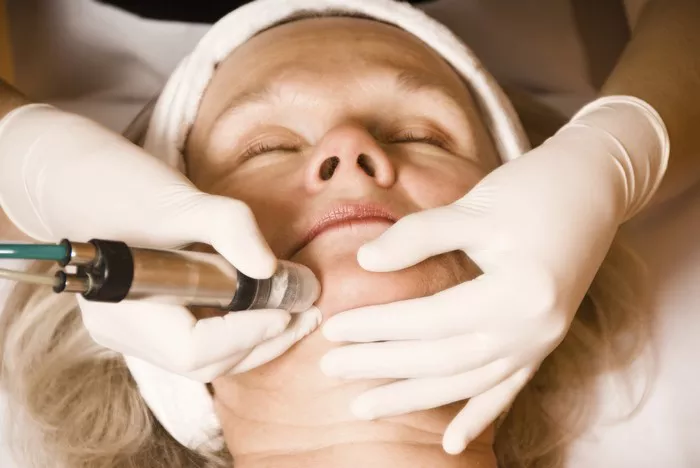In the ever-evolving landscape of skincare, individuals are presented with an array of rejuvenating techniques, each promising to unveil smoother and more radiant skin. Two prominent contenders in this realm are microdermabrasion and dermaplaning. In this comprehensive exploration, we delve into the nuances of these skincare procedures, dissecting the key differences, benefits, and considerations to help answer the perennial question: Microdermabrasion vs. Dermaplaning – Which is better for your skin?
Understanding Microdermabrasion: A Closer Look
1. The Basics of Microdermabrasion:
Microdermabrasion stands as a stalwart in the realm of non-invasive exfoliation. This section provides an overview of the microdermabrasion process, detailing the use of abrasive crystals or a diamond-tipped wand to gently remove the outer layer of dead skin cells. The goal is to uncover a fresh and revitalized complexion.
2. Benefits of Microdermabrasion:
Microdermabrasion brings a myriad of benefits to the table. From addressing uneven skin tone and reducing the appearance of fine lines to promoting collagen production, this section explores the positive outcomes that individuals can expect from incorporating microdermabrasion into their skincare routine.
3. Considerations and Skin Types:
Not all skin types are created equal, and microdermabrasion’s efficacy can vary accordingly. This part delves into considerations for different skin types, offering insights into how individuals with oily, dry, sensitive, or acne-prone skin can navigate the world of microdermabrasion.
Dermaplaning Unveiled: A Gentle Approach to Smoother Skin
1. Defining Dermaplaning:
Dermaplaning takes a distinctive approach to exfoliation, relying on a surgical scalpel to remove not only dead skin cells but also fine facial hair. This section provides a detailed explanation of the dermaplaning process, highlighting its unique characteristics and objectives.
2. The Advantages of Dermaplaning:
Dermaplaning offers a set of advantages that set it apart from other exfoliation methods. From immediate improvement in skin texture to enhanced product absorption, this segment explores the perks of choosing dermaplaning as part of a skincare regimen.
3. Skin Sensitivity and Dermaplaning:
Sensitivity is a crucial factor when considering skincare procedures. Here, we delve into how dermaplaning caters to individuals with sensitive skin, providing a gentler alternative to traditional exfoliation methods and addressing concerns related to redness and irritation.
Microdermabrasion vs. Dermaplaning: Navigating the Differences
1. Exfoliation Depth and Mechanism:
The fundamental difference between microdermabrasion and dermaplaning lies in their exfoliation depth and mechanisms. This section dissects how microdermabrasion focuses on the outermost layer of the skin, while dermaplaning delves deeper, offering a more intensive form of exfoliation.
2. Hair Removal Distinction:
An intriguing aspect that sets dermaplaning apart is its dual functionality in removing facial hair. This part explores how dermaplaning addresses not only dead skin cells but also fine vellus hair, contributing to a smoother and fuzz-free complexion.
3. Addressing Specific Skin Concerns:
Microdermabrasion and dermaplaning cater to distinct skin concerns. This segment breaks down how microdermabrasion is well-suited for addressing texture irregularities, while dermaplaning excels in providing a canvas for smoother makeup application and tackling certain types of hyperpigmentation.
Choosing the Right Technique: Factors to Consider
1. Skin Goals and Desired Outcomes:
The choice between microdermabrasion and dermaplaning ultimately hinges on individual skincare goals. This section guides readers through assessing their desired outcomes, whether focused on texture refinement, hair removal, or a combination of both.
2. Frequency and Maintenance:
Both microdermabrasion and dermaplaning require thoughtful consideration of frequency and maintenance. This part provides insights into how often these procedures can be performed and the subsequent skincare routines necessary to maximize their benefits.
3. Professional vs. At-Home Considerations:
While both microdermabrasion and dermaplaning can be administered by skincare professionals, at-home options exist. This section explores the considerations for choosing between professional salon treatments and the convenience of at-home kits.
Safety and Potential Risks: A Prudent Approach
1. Skin Safety Measures:
Prioritizing skin safety is paramount in any skincare journey. Here, we discuss the safety measures associated with both microdermabrasion and dermaplaning, emphasizing the importance of consulting with skincare professionals and adhering to recommended guidelines.
2. Potential Risks and Side Effects:
No skincare procedure is without potential risks. This segment outlines the common side effects and potential risks associated with microdermabrasion and dermaplaning, providing readers with a comprehensive understanding of what to expect.
Conclusion
In conclusion, the choice between microdermabrasion and dermaplaning is deeply personal and contingent on individual skincare goals, preferences, and skin types. By unraveling the intricacies of these two exfoliation techniques, individuals can make informed decisions that align with their unique needs. Whether opting for the precision of dermaplaning or the versatility of microdermabrasion, the journey towards radiant and rejuvenated skin is an exploration worth undertaking – a testament to the diverse world of skincare innovations.

